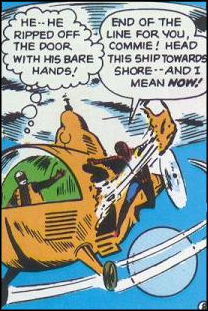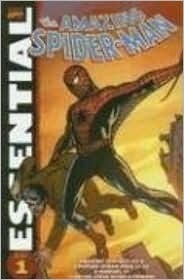Reading The Amazing Spider-Man: Issue Number One Part Two
Part Two of the The Amazing Spider-Man issue number one begins with another abstract splash page: it's "Spider-Man vs. The Chameleon!" with the Chameleon looming menacingly and larger than life over the city as the amazing Spider-Man swings in to deliver a well-placed shot of webbing directly in the villain's eye slits.
The cover copy asks breathlessly,
How can you catch a man who can change his identity before you can catch him?? Perhaps you don't know the answer, but Spider-Man was determined to find out — no matter what the cost!
It's interesting that Stan Lee (we assume) opted to use the past-tense in that copy, as if the story had already happened and this is just a recap… perhaps of actual events? As in part one of issue number one, it's got a very pulp magazine feel.
A big chunk of this splash page is dedicated to an "Extra bonus extra!!" enthusiastically (to say the least) informing us this story will also feature "America's most famous, most colorful group of super-adventurers The Fantastic Four!!" What's kind of funny is that the Fantastic Four isn't really all that colorful in a literal sense…they all wore blue jumpsuits except for the Thing, who had to settle for blue boxing trunks. Yawn!
Synopsis
Turn the page and start the story… straight away, young Peter Parker demonstrates his entrepreneurial spirit when it occurs to him that he can make money by joining the Fantastic Four. At the very least, I suppose, he could add some red to their roster and help them live up to that "most colorful" claim.
Interestingly, he visits the headquarters of the Fantastic Four as Peter Parker. Maybe after the story in The Amazing Spider-Man number one part one, he realizes he won't be able to cash a paycheck as anyone but his true identity and decides that's worth dropping the secret, at least as far as his prospective employers are concerned?
We'll never know. He can't get into the Fantastic Four's private elevator without one of their key-gizmos, so he switches to the amazing Spider-man and uses a web line to walk to the Fantastic Four's penthouse digs from an adjoining building.
The Fantastic Four have had some bad luck with security (their entire building was stolen by Doctor Doom) and so have a sophisticated security system in place. Alarms go off and cameras show that Spider-Man is on his way. The team is bewildered he didn't "phone for an appointment, like anyone else," so even though they leave a window open for him, they activate defense measure B "just to be safe."
Spider-Man swings through the window frame, only to find himself in a plexiglass cage that drops from the ceiling. He quickly pries the glass open, causing the thrifty leader of the Fantastic Four, the modestly monikered "Mister Fantastic," to cry,
That device cost us thousands! If you wreck it–
The Thing lightly swings at Spider-Man to teach him some manners, but our hero easily tosses the giant rocky strongman into the Human Torch, who must be the slowest-reacting flying human in the Marvel universe. More fighting happens, though Spider-Man claims it's only a demonstration of what he can do. Finally, he spells it out for them:
I came up here to join up with you! I wanna be a member of the Fantastic Four! So, now, let's get down to business… how much does the job pay? I figure I'm worth your top salary!
Man, that Peter Parker… what a dick. The Fantastic Four basically agree… and they bring up that little matter of the amazing Spider-Man being wanted by the police! Embarrassed and offended, Spider-Man swings out the way he came in, a pouty "Who needs you?" on his lips. The Invisible Girl regrets the way things turned out, but Mister Fantastic, being the genius of the group, has a feeling "we'll be hearing more from that young man in the future!"
That's a great place to switch scenes. In the very next panel, in "a defense installation at the edge of town," the villain of our piece employs a little verbal exposition when he tells the man he's tied up,
With my multi-pocket disguise vest, it will be an easy matter for the Chameleon to become you, friend janitor!
The Chameleon gains access to a restricted area, utilizes a terrible wig, fake beard and Groucho Marx glasses to impersonate a professor, and steals the first half of some missile defense plans right under the noses of the scientists in the room.
Back at the Chameleon's hideout, he learns of the amazing Spider-Man's drop-in on the Fantastic Four and, in a Holmesian demonstration of deduction, figures out that our hero must have been looking for a job because being wanted by the police makes it impossible to earn a "legitimate living." It's almost as if the Chameleon has been reading Stan Lee's scripts.
Hm. Come to think of it, has anyone ever seen Stan and the Chameleon in the same place at the same time? You don't think…
Never mind.
The Chameleon decides Spider-Man will make the perfect fall guy when he steals the second half of the missile defense plans. At this point we learn there's much more to the Chameleon than we'd been led to believe so far.
Apparently the Chameleon is some kind of genius of electronics and biomechanics. He susses out that the amazing Spider-Man has the "powers and instincts of a spider" and creates a transmitter specially designed to send a message in english that only Spider-Man will hear.
Calling Spider-Man! Meet me on the roof of the Lark Building at ten tonight! It will be very profitable for you!
With genius-level skills like this, why is the Chameleon slinking around in bad disguises pulled out of his puffy brown vest? He's got the makings of a world-class supervillain, but as we'll see in later decades, he never quite makes the grade despite causing a lot of trouble for the amazing Spider-Man.
Speaking of our hero, he takes the bait since "I can't afford to pass up a chance for profit!" Just before they're to meet, the Chameleon, disguised as Spider-Man and armed with a web-shooting gun, steals the second half of the missile defense plans and zips away in a helicopter he left on the roof.
Spider-Man sees the helicopter leaving right before he arrives at the Lark Building… in time for the cops to rush him, thinking he's the thief! Spider-Man immobilizes the cops with his web and takes off in pursuit of the helicopter.
It's here that we're shown another handy use of his "spider's senses" — not only can he receive radio transmissions tuned to his frequency, he can also "tune in" on the helicopter! Later, the amazing Spider-Man's "spider sense" would be limited to a kind of very short-term early warning system to keep him out of immediate danger. Here in the very first issue of his comic, the creators were apparently still deciding just how versatile his extra-sensory perception would be… and the answer to that is, "as versatile as we need it to be for the purposes of the plot."
This story also shows us how remarkable the amazing Spider-Man's synthetic web could be, too. It's incredibly elastic: Spider-Man uses it as a kind of slingshot to propel him far over the city in his pursuit of the Chameleon's helicopter, all the way to the docks. There, he fashions a parachute out of the webbing to lightly descend.
The Chameleon is on his way to rendezvous with a Soviet submarine that has surfaced off shore, so Spider-Man — no stranger to vehicular theft in the line of duty, as we've already seen — commandeers a speedboat to reach the sub.
When the Russians realize the hatch of the sub's tower has been jammed shut by Spider-Man's webbing, they bail. Spider-Man lets the speedboat ram the sinking sub when he attaches himself to the helicopter with a webline. I feel sorry for the owner of that boat… he'll never know what happened to it!
 Despite a lot of loop-dee-loops (I'm no expert, but I don't think helicopters can do that…) the Chameleon can't dislodge our hero. Spider-Man rips the door off the helicopter and — no doubt adopting his best "stern adult super-hero" voice — tells the Chameleon,
Despite a lot of loop-dee-loops (I'm no expert, but I don't think helicopters can do that…) the Chameleon can't dislodge our hero. Spider-Man rips the door off the helicopter and — no doubt adopting his best "stern adult super-hero" voice — tells the Chameleon,
End of the line for you, commie! Head this ship towards shore — and I mean now!
The Chameleon knows when he's beat… for now. He pilots the helicopter back to the roof of the Lark Building, where Spider-Man turns him over to waiting police.
But!
The Chameleon drops a smoke pellet, gets away, disguises himself as a cop, douses the lights and tries to slip away. Spider-Man can still sense him in the dark, however (really?) and we're introduced to one of the most enduring tropes of the book: just when he's about to web up the bad guy, Spider-Man runs out of web fluid.
I don't buy it. Peter Parker is crazy smart. He designed this poly-carbon web fluid… stuff that can be sticky enough to "web" people up or pliable enough to shape into a parachute… and he designed and modded up the web shooters to dispense it. Why on earth wouldn't he have thought to include some kind of meter that would let him know he's running low?
But no. Over and over again, especially in the seventies, just when he needs it the most, the amazing Spider-Man runs out of web fluid. Does he run out of web fluid… or do the writers run out of plot twists? Hm.
Anyway, unable to subdue the Chameleon from a distance, the amazing Spider-Man goes for the direct approach. He's grappling with his foe just as the lights go up… and the police see Spider-Man grappling with one of their own!
They jump Spider-Man, thinking he's the Chameleon. That's it for our hero. Frustrated and pissed, he ditches the whole scene, grousing in a thought-bubble,
Every time I try to help, I get into worse trouble! Well, they can catch that spy themselves now!"
The thing is, the police do just that. The Chameleon tore his disguise in the scuffle, revealing the fake Spider-Man costume beneath, and the cops round him up.
Spider-Man's running away by now — I mean "losing himself in the shadows of the silent night" — , actually sobbing and wishing he'd never gotten his super powers.
This story ends much as the first: with the question (this time posed by the concerned Fantastic Four) of whether or not the confused, powerful Spider-Man will turn against the law. With this gun on the mantle piece laid out so often, we should expect that's exactly what will happen before too long. Right? I guess we'll have to wait until the next issue!
Thoughts On Issue One Part Two of The Amazing Spider-Man
Like the first story in issue number one of The Amazing Spider-Man, we see here how Spider-Man isn't really all that heroic just yet. As with the previous tale, his motivations are entirely driven by the need to get get money, not to battle bad guys because it's simply the right thing to do when you're blessed with super-powers.
Fine, I'll give you the fact that he's trying to raise money to help support his doting, widowed aunt… who woudn't be a widow if not for Peter Parker's egotistical negligence. But speaking of that ego… wow! The way he treats the Fantastic Four, it's a wonder they didn't toss him right back out of that window and told him to web himself up a nice hang-glider or something equally improbable and ridiculous before he goes splat.
Then there's how easily he fell into a temper tantrum when the cops turned on him a second time. He actually abandoned the fight! He actually turned his back on a situation where he had the power and opportunity to stop a dangerous criminal. The last time he did this, the bad guys shot his uncle to death. What would make Peter Parker so easily forget that with great power comes great responsibility?
Well, let's think about that one. He's sixteen years old, give or take. A few weeks ago, his life was changed forever when he was blessed with remarkable powers and cursed with the tragedy of his uncle's violent death — a death he could have prevented.
His whole young life, his bookish ways and prodigious intellect have branded him a pariah among his peers… and now he is secretly the object of their admiration and respect… while the authority figures he's respected have turned against him!
Frankly, this kid should be having a nervous breakdown. In fact, in these early issues of The Amazing Spider-Man… he might be. No wonder people suspect him of breaking the law, or fear he'll turn criminal… he comes across as unstable and erratic, the kind of kid you root for, but something's not quite right, too.
Now, I'm not saying Stan Lee and Steve Ditko looked this deeply into Peter Parker's character when they wrote these early tales. I strongly doubt they were after anything other than telling fun, compelling stories. But deliberately or not, they laid the groundwork for a new mythology by presenting a character whose flaws are as deep as his powers are, well, amazing.
As creators crafting story worlds that could become story franchises, we can take a lesson here: flawed characters are compelling characters. Give your hero plenty of un-heroic tendencies, especially if his faults are the result of some tragedy he can (or might not!) overcome. Your audience will come back again and again to see how it will all turn out, just as we've been waiting to see what happens next in the life of the amazing Spider-Man for over four decades.
So! Is your hero imperfect, flawed, troubled, a little bit of a jerk? Does he need to be to make your story more compelling? Let's talk about it in the comments!
The Amazing Spider-Man number one part two
"Spider Man vs. The Chameleon!"
Cover Date: March, 1963
Script: Stan Lee
Art: Steve Ditko
Lettering: John Duffi
Join Me In Reading The Amazing Spider-Man
Click the cover to buy the first twenty issues of The Amazing Spider-Man in an inexpensive trade paperback:

Your purchase helps support this series and all my creative endeavors — thanks!
Matthew Wayne Selznick - Telling stories with words, music, pictures and people.










